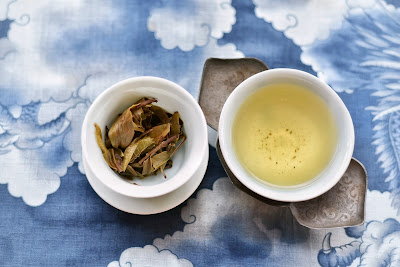This morning, I noticed a swimmer on lane 1 swimming at a fast pace. For 5 laps, I managed to keep up with him, but then, exhausted, I had to let him go ahead of me. It's my competitive spirit to often try to excel and be better than others. I think I would have loved to live during the Sung dynasty and compete for the tea foam that lasts longest in one's black glazed bowl!
As a tea collector and tea enthusiast, I also try to find what's best. It's not just for the pleasure of being number one, but more to know what it is like when you come close to perfection. Usually, for me, it is a pretty good feeling! One thing that all great teas have in common is a prolonged aftertaste. This means that you can enjoy them long after finishing your cup. Such teas become companions, a presence of pure, natural aromas and sweet, energetic taste.
In the last 10 years, it has become more and more difficult to find excellent young puerh. Market prices for old arbor puerh have been rising every year in Yunnan, while the quality of the leaves decreased progressively. Some very old trees became protected and off limits to producers, while others became overexploited. Formerly abandoned plantations of old puerh trees are tended with fertilizers to increase production...
However, high prices also had the effect of making remote wild forests more accessible and worth exploring. That's how one of my contacts in Yunnan found a several wild puerh trees estimated around 500 years old in a remote, rocky and secret forest in Yunnan. Apparently, these trees had never been harvested before according to the villagers who live closest to this spot.
This is a familiar story that we have read and heard many times during the last ten years. It's completely normal to be suspicious and careful at this point. The best thing to do at this point is to listen to the leaves.
This means brewing a rather small amount of this puerh in a porcelain gaiwan for a long time. It's the method most tea judges use to evaluate a tea. The porcelain vessel ensures a certain neutrality of taste. And the long brewing time means you are pushing the leaves to their limits: only the best tea still tastes great when brewed extra long.
What happens next is that you analyze and compare this tea to all the other young raw puerhs that you have experienced so far. I think I have tasted a great number of cakes, loose leaves... of fresh puerh in the last 15 years, but this one tops them all when it comes to purity, energy and sweetness.
Right now, this puerh has a sweet scent of jasmine flowers. Like the taste, the scents are very pure, natural and clean.
What I find most enjoyable and fascinating with this puerh is the purity and harmony of its aromas. It's like a solo concert of virtuoso violin player instead of an orchestra. There's only one note, but it is both powerful and elegant.
The tea friends with whom I have tasted this cake so far were all amazed by how great it tastes when considering its young age. It's more than simply drinkable! This is consistent with my experience of great puerhs like my 2003 wild Yiwu and the 2006 wild Lincang: they were all a pleasure to brew from day 1!
What about its price? Isn't it much more expensive than old arbor puerh from 10 years ago? Of course, it is much more expensive, but there is no going back to these price levels. Wages and living standards have increased a lot in China and among tea farmers in Yunnan. And for Chinese consumers of such top quality teas, money isn't a problem anymore.
How do I justify the fact that I purchased several tongs of this puerh? From a value point of view, good puerh packs more aromas than other teas. That's one reason why it's possible to age it. I usually use fewer leaves with puerh and I am able to get more brews from them. So, on a cup basis, this puerh is still cheaper than Oolong from DaYuLing!
My second justification is that this puerh tastes so good that I actually believe that it comes from a remote forest of aged trees that have been harvested for the first time. This level of purity is at its peak this year. Who knows how the village will handle the next harvests? By paying the requested price without bargaining, I hope that the trees will be treated in a sustainable way to keep the quality highest. However, this is out of my control. All I can do is keep the place a secret so that few buyers show up there. In any case, the quality of a first harvest is difficult to be topped and tea prices of such old arbor puerh are likely to continue to increase in the future.
It took 10 years for such an opportunity to present itself. With my character, I couldn't pass this chance of owning, selling and frequently enjoying the best fresh raw wild puerh I had ever tasted!
This is the one!
The one that defines quality and purity in wild, old arbor puerh.
The one tea to rule the kings of puerh.
The one tea with limitless aging potential.
The one tea to bring on a desert island.
The one tea that you should experience once in your life.
And to make this tasting affordable, I have made the one available as 10 grams sample. This should be enough for at least 3 sessions of many brews.
Note: this puerh has been tested for chemicals in China and Taiwan, and both reports showed that all unwelcome chemicals were indeed absent from these leaves.
Listening for Silence
1 day ago




















No comments:
Post a Comment